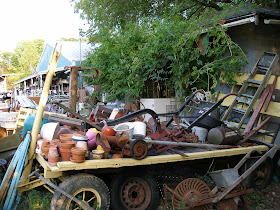
Nick Tosches spent years researching the 1920s musician Emmett Miller, who had been quite famous in his day yet left almost no trace of his existence just a half century later. His quest to know more about the man became an obsession that spanned decades, and finally bore fruit, as detailed in his book "Where Dead Voices Gather".
Perhaps one day scholars will plumb the depths of the mysteries of Kentucky's James Harrod as well - but I wouldn't bet on it. Harrod is a key part of Kentucky history, yet one whose record is smudged in places and completely blank in others.
We dont know when he was born and we don't know when he died. We have no photographs or paintings of his likeness. We know almost nothing about his early life. We do know he served in the French and Indian War, and was probably underage when he did so. We also know he was an important early settler of Kentucky, in every way a peer of Daniel Boone and George Rogers Clark, yet his name is not a household word. (Well, then again, in a way it is for some: Harrod founded the first permanent settlement in Kentucky in 1774 and we know it today as the city pictured above.... Harrodsburg.)
In February 1792, Harrod left on a hunting trip in the wilderness of Kentucky and was never seen again.
There are as many theories and explanations for his vanishing as there are JFK conspiracy theories, and we'll probably never know the truth.
Some say he was a bigamist and had another wife and family, to whom he returned to under another name, and was likely buried under this pseudonym. Others tell of a pair of woodsmen held captive by Indians in Michigan meeting a fellow prisoner referred to as "Colonel Harrod." And yet another account has it that Harrod had been killed by one of his fellow hunters, a man named Bridges, and that the secret purpose of their hunting expedition was to search for Jonathan Swift's fabled silver mine. Supposedly this Bridges guy was caught selling silver buttons from Harrod's coat, conveniently engraved with the letter "H", at a Lexington shop.
Then there's the bizarre tale that some of Harrod's friends found his skeleton in a cave, wrapped in grass. However, some say the skeleton was wearing Harrod's shirt and some say it wasn't. Supposedly, Harrod's family believed the skeleton to be his, so the question then becomes, why didn't they bury the skeleton and give him a proper gravestone? And why then, when Ann applied for Harrod's pension, did she swear he had died in a hunting accident and that his clothes had been found in a nearby river but his body never found?
The most logical explanation, to me, would be that he simply died in the woods and no one ever found his body, which probably was torn apart by wild animals. But according to the
James Harrod Trust, "In the 1880s a rumor circulated that Bridges, who had returned to Virginia, confessed on his deathbed to the Harrod murder and revealed the place of his burial in what is now Estill County, Kentucky".
Or maybe he encountered the
Devil Deer.
I'm not exactly weeping copious tears for Harrod, though - he actively opposed Daniel Boone and Richard Henderson's
Transylvania purchase, and added and abetted the crooked land grab from Virginia. He went on to represent Virginia's "Kentucky County" in the Virginia House of Delegates. Many people, your humble author included, believe that most of the area should still be known as Transylvania because it was improperly wrested from Boone and Henderson's hands by the state of Virginia before regaining its independence.


















































